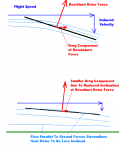WaspAir
Supreme Allied Gyro CFI
- Joined
- Oct 21, 2006
- Messages
- 6,829
- Location
- Colorado front range
- Aircraft
- Bell 47G-3B-1, A&S 18A, Phoebus C, SGS 1-26A, etc.
- Total Flight Time
- rather a lot
Actually that sounds more like you were overloaded and flying behind the power curve. Of course, I was not in the cockpit with you so it is just speculation, because that happened to me as well in a SxS Air Command when flying in Venezuela many moons ago.
No way. I was not "behind the power curve". I was at best rate of climb speed (around 70 mph), and solo in the aircraft with just my skinny 140 lb body. But I was at/just above the aircraft's absolute ceiling with that combination of load and density altitude (converting in my head, I'm pretty sure that well over 4000 ft + 113 degrees is substantially over 8000 DA). Without ground effect to help, the J-2 would not have flown at all.
The terrain was free of obstructions for many miles ahead (just some tumbleweed), and I continued in runway direction skimming above the ground. I could hold ten feet AGL, but where the terrain went slightly lower, so did I, and similarly for little rises. If there had been a drop off down to 3500 feet, I would not have been able to hold my MSL altitude above it because the ground effect would have been lost.
I understand reluctance to compare helicopter and gyro ground effect because of the confusion of hovering flight with translational motion. But in practical terms, a gyro in my situation benefits from ground effect just as a fixed wing would.

